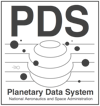PDS4 Standards - PSA
INTRODUCTION TO PDS

The Planetary Data System (PDS) Standard provides guidelines on how a data producer should construct a data set suitable for long-term archiving. The standard contains a number of requirements in terms of data set structure and documentation that should allow for any PDS compliant data set to be used and understood many years after the close of a mission. In addition, the use of the standards should allow for cross compatibility with any other PDS compliant data set.
When the PSA was first established, PDS version 3 was in place, and was used for all missions (SMART-1, Huygens, Mars Express, Venus Express and Rosetta). This standards version is described in further detail below. The newer version of the standards (PDS4), is now in use on ExoMars, BepiColombo and our future missions. Learn more about PDS3 here.
OVERVIEW OF PDS4 STANDARD
Each PDS4 data product consists of two files, one containing the data and an xml file containing the label. PDS4 recognises four base data structures, array, table, parsable byte stream and encoded byte stream with arrays and tables most commonly in use. An introduction to PDS4 can be found in the PDS4 Concepts Document.
PDS4 Data Structures in the PSA
PDS4 products are organised at the top level into bundles. There is no PDS standard for how an archive is subdivided into bundles but a common cross-mission approach has been adopted by the PSA. This is to divide each mission data into one bundle for each instrument plus one "mission" bundle for non-instrument specific data e.g. spacecraft housekeeping, mission documentation etc. When PDS4 products are downloaded from the PSA they will appear in a directory structure where the bundles are the top level directories and these will typically be the named as the instrument from which the data is obtained.
Each bundle consists of a set of collections. Again a common approach has been adopted for the PSA where collections must be one of the following (internal to PSA) types:
- data
- calibration
- document
- geometry
- browse
- miscellaneous
- context
- spice_kernels
- xml_schema
Therefore one or more of these types will appear in the first level of bundle subdirectories. At present all collections except data and miscellaneous will be named as above. Instrument data is put into at least four collections, one for each of the four PDS4 data processing levels i.e. data_raw, data_partial, data_calibrated and data_derived. If necessary more than one collection can be constructed for a data processing level and this is expected in particular for derived data. Miscellaneous will typically appear as miscellaneous_ancillary e.g. this is the collection used by ExoMars 2016 to store spacecraft housekeeping in the mission bundle.
The structure of data below the collection level is largely mission specific and dependent on the collection type. However data collections in the PSA must be subdivided by mission phase. At present ExoMars 2016 is the only operational mission in the PSA. For near earth checkout phase, products will appear in a flat structure, for cruise phase products are subdivided into separate driectories covering one week each and for phases at Mars the products will be subdivided acording to groups of orbits then one directory per orbit.
- Removed a total of (1) style float:left;








































 Sign in
Sign in
 Science & Technology
Science & Technology